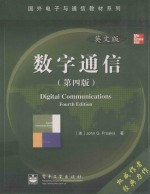

数字通信 第4版 英文版 digital communications foruth editionPDF电子书下载
- 电子书积分:20 积分如何计算积分?
- 作 者:
- 出 版 社:
- 出版年份:2222
- ISBN:
- 页数:0 页
1 Introduction 1
1.1 Elements of a Digital Communication System 1
1.2 Communication Channels and Their Characteristics 3
1.3 Mathematical Models for Communication Channels 10
1.4 A Historical Perspective in the Development of Digital Communications 13
1.5 Overview of the Book 15
1.6 Bibliographical Notes and References 16
2 Probability and Stochastic Processes 17
2.1 Probability 17
2.2 Stochastic Processes 61
2.3 Bibliographical Notes and References 75
Problems 75
3 Source Coding 80
3.1 Mathematical Models for Information Sources 80
3.2 A Logarithmic Measure of Information 82
3.3 Coding for Discrete Sources 90
3.4 Coding for Analog Sources—Optimum Quantization 103
3.5 Coding Techniques for Analog Sources 121
3.6 Bibliographical Notes and References 140
Problems 141
4 Characterization of Communication Signals and Systems 148
4.1 Representation of Band-Pass Signals and Systems 148
4.2 Signal Space Representations 158
4.3 Representation of Digitally Modulated Signals 168
4.4 Spectral Characteristics of Digitally Modulated Signals 201
4.5 Bibliographical Notes and References 221
Problems 222
5 Optimum Receivers for the Additive White Gaussian Noise Channel 231
5.1 Optimum.Receiver for Signals Corrupted by Additive White Gaussian Noise 231
5.2 Performance of the Optimum Receiver for Memoryless Modulation 254
5.3 Optimum Receiver for CPM Signals 283
5.4 Optimum Receiver for Signals with Random Phase in AWGN Channel 300
5.5 Performance Analysis for Wireline and Radio Communication Systems 313
5.6 Bibliographical Notes and References 318
Problems 319
6 Carrier and Symbol Synchronziation 333
6.1 Signal Parameter Estimation 333
6.2 Carrier Phase Estimation 338
6.3 Symbol Timing Estimation 359
6.4 Joint Estimation of Carrier Phase and Symbol Timing 366
6.5 Performance Characteristics of ML Estimators 368
6.6 Bibliographical Notes and References 371
Problems 372
7 Channel Capacity and Coding 376
7.1 Channel Models and Channel Capacity 376
7.2 Random Selection of Codes 392
7.3 Communication System Design Based on the Cutoff Rate 402
7.4 Bibliographical Notes and References 408
Problems 409
8 Block and Convolutional Channel Codes 416
8.1 Linear Block Codes 416
8.2 Convolutional Codes 471
8.3 Coded Modulation for Bandwidth-Constrained Channels—Trellis-Coded Modulation 522
8.4 Bibliographical Notes and References 539
Problems 541
9 Signal Design for Band-Limited Channels 548
9.1 Characterization of Band-Limited Channels 548
9.2 Signal Design for Band-Limited Channels 554
9.3 Probability of Error in Detection of PAM 574
9.4 Modulation Codes for Spectrum Shaping 578
9.5 Bibliographical Notes and References 588
Problems 588
10 Communication Through Band-Limited Linear Filter Channels 598
10.1 Optimum Receiver for Channels with ISI and AWGN 599
10.2 Linear Equalization 616
10.3 Decision-Feedback Equalization 638
10.4 Reduced Complexity ML Detectors 647
10.5 Iterative Equalization and Decoding—Turbo Equalization 649
10.6 Bibliographical Notes and References 651
Problems 652
11 Adaptive Equalization 660
11.1 Adaptive Linear Equalizer 660
11.2 Adaptive Decision-Feedback Equalizer 677
11.3 Adaptive Equalization of Trellis-Coded Signals 678
11.4 Recursive Least-Squares Algorithms for Adaptive Equalization 682
11.5 Self-Recovering(Blind)Equalization 693
11.6 Bibliographical Notes and References 704
Problems 705
12 Multichannel and Multicarrier Systems 709
12.1 Multichannel Digital Communications in AWGN Channels 709
12.2 Multicarrier Communications 715
12.3 Bibliographical Notes and References 723
Problems 724
13 Spread Spectrum Signals for Digital Communications 726
13.1 Model of Spread Spectrum Digital Communication System 728
13.2 Direct Sequence Spread Spectrum Signals 729
13.3 Frequency-Hopped Spread Spectrum Signals 771
13.4 Other Types of Spread Spectrum Signals 784
13.5 Synchronization of Spread Spectrum Systems 786
13.6 Bibliographical Notes and References 792
Problems 794
14 Digital Communications through Fading Multipath Channels 800
14.1 Characterization of Fading Multipath Channels 801
14.2 The Effect of Signal Characteristics on the Choice of a Channel Model 814
14.3 Frequency-Nonselective,Slowly Fading Channel 816
14.4 Diversity Techniques for Fading Multipath Channels 821
14.5 Digital Signaling over a Frequency-Selective,Slowly Fading Channel 840
14.6 Coded Waveforms for Fading Channels 852
14.7 Multiple-Antenna Systems 878
14.8 Bibliographical Notes and References 885
Problems 887
15 Multiuser Communications 896
15.1 Introduction to Multiple Access Techniques 896
15.2 Capacity of Multiple Access Methods 899
15.3 Code-Division Multiple Access 905
15.4 Random Access Methods 922
15.5 Bibliographical Notes and References 931
Problems 933
Appendix A The Levinson-Durbin Algorithm 939
Appendix B Error Probability for Multichannel Binary Signals 943
Appendix C Error Probabilities for Adaptive Reception of M-Phase Signals 949
C.1 Mathematical Model for M-Phase Signaling Communication System 949
C.2 Characteristic Function and Probability Density Function of the Phase θ 952
C.3 Error Probabilities for Slowly Rayleigh Fading Channels 953
C.4 Error Probabilities for Time-Invariant and Ricean Fading Channels 956
Appendix D Square-Root Factorization 961
References and Bibliography 963
Index 993
- 《计算机网络与通信基础》谢雨飞,田启川编著 2019
- 《数字影视特效制作技法解析》王文瑞著 2019
- 《卓有成效的管理者 中英文双语版》(美)彼得·德鲁克许是祥译;那国毅审校 2019
- 《AutoCAD 2018自学视频教程 标准版 中文版》CAD/CAM/CAE技术联盟 2019
- 《数字插画实战 人像创作30例》王鲁光著 2019
- 《跟孩子一起看图学英文》张紫颖著 2019
- 《通信电子电路原理及仿真设计》叶建芳 2019
- 《AutoCAD机械设计实例精解 2019中文版》北京兆迪科技有限公司编著 2019
- 《中国电子政务发展报告 2018-2019 数字中国战略下的政府管理创新》何毅亭主编 2019
- 《复分析 英文版》(中国)李娜,马立新 2019
